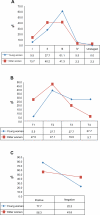Hormone receptor status in breast cancer and its relation to age and other prognostic factors
- PMID: 21695095
- PMCID: PMC3117624
- DOI: 10.4137/BCBCR.S7199
Hormone receptor status in breast cancer and its relation to age and other prognostic factors
Abstract
Background: Increasing evidence shows the importance of young age, estrogen receptor (ER), progesterone receptor (PR) status, and HER-2 expression in patients with breast cancers.
Patients and methods: We organized an analytic cross-sectional study of 105 women diagnosed with breast cancer who have been operated on between 2008 to 2010. We evaluated age, size, hormone receptor status, HER-2 and P53 expression as possible indicator of lymph node involvement.
Results: There is a direct correlation between positive progesterone receptor status and being younger than 40 (P < 0.05). Also, compared with older women, young women had tumors that were more likely to be large in size and have higher stages (P < 0.05). Furthermore patients with negative progesterone receptor status were more likely to have HER-2 overexpression (P < 0.05). The differences in propensity to lymph node metastasis between hormone receptor statuses were not statically significant.
Conclusions: Although negative progesterone receptor tumors were more likely to have HER-2 overexpression, it is possible that higher stage and larger size breast cancer in younger women is related to positive progesterone receptor status.
Keywords: age; breast cancer; estrogen receptor; lymph node metastasis; progesterone receptor.
Figures
References
-
- American Cancer Society Cancer Facts and Figures, 2004. 2004;3:10.
-
- Albain KS, Allred DC, Clark GM. Breast cancer outcome and predictor of outcome: are there age differentials? J Natl Cancer Inst Monogr. 1994;16:35–42. - PubMed
-
- Shannon C, Smith IE. Breast cancer in adolescents and young women. Eur J Cancer. 2003;39:2632–42. - PubMed
-
- Anders CK, Hsu DS, Broadwater G, et al. Young age at diagnosis correlates with worse prognosis and defines a subset of breast cancers with shared patterns of gene expression. J Clin Oncol. 2008;26:3324–30. - PubMed
LinkOut - more resources
Full Text Sources
Research Materials
Miscellaneous


